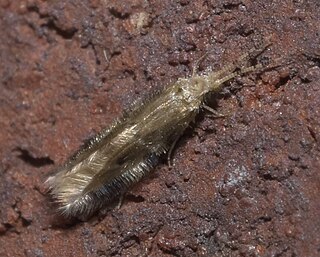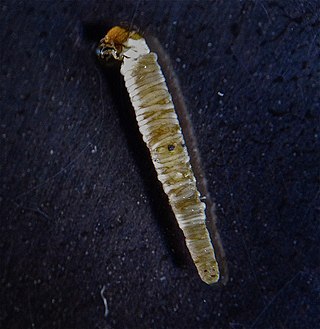
The family Leptoceridae are a family of caddisflies often called "long-horned caddisflies" or "silverhorns". Leptoceridae is the second largest family of caddisflies with over 1850 species in approximately 68 genera. The main identifying feature of most Leptoceridae is that their antennae are much longer than those of other caddisflies. There is one genus with relatively short antennae (Ceraclea), but it is easily identified by the pair of dark curved lines on the mesonotum.

The Hydroptilidae are a large family of caddisflies (Trichoptera) with a worldwide distribution. They are commonly known as microcaddisflies or purse-case caddisflies, in reference to two characteristic traits of this family: Hydroptilidae are much smaller than other caddisflies, rarely exceeding 5 mm (0.20 in) in length. Their larvae do not build a protective case until the final instar of their growth. At that time however, they build a typically Purse-shaped case, either portable or stuck to the substrate, in which the larva finishes growth and pupates.

The Ecnomidae are a family of caddisflies comprising 9 genera with a total of 375 species.

The Psychomyiidae are a family of tube-making caddisflies. Members of this family are typically very similar to polycentropodids, most of them can be differentiated by the spur formula is 2-4-4, thyridial cell short, absence of the forewing fork I, and hindwing forks I and IV. Male genitalia has elongate preanal appendages, and reduced tergum IX. The larvae differ by the submental sclerites separated, foretrochantin broad, and the pupal mandible apex whip-like. Larvae construct long silken galleries.
Culoptila aguilerai is a species of caddisfly, known from fossils preserved in Mexican amber. The species is named after Eliseo Palacios Aguilera.

Micrasema is a genus of humpless casemaker caddisflies in the family Brachycentridae. There are more than 70 described species in Micrasema.
Phylloicus is a genus of caddisflies in the family Calamoceratidae. There are more than 40 described species in Phylloicus.
Cernotina is a genus of tube maker caddisflies in the family Polycentropodidae. There are more than 70 described species in Cernotina.

Hydroptilinae is a subfamily of microcaddisflies in the family Hydroptilidae. There are at least 60 genera and 1,600 described species in Hydroptilinae.

Nectopsyche is a genus of white millers in the family Leptoceridae. There are at least 70 described species in Nectopsyche.

Diplectrona is a genus of netspinning caddisflies in the family Hydropsychidae. There are a large number of species within Diplectrona. Catalogue of Life and Integrated Taxonomic Information System accept 87 species, while others, including Global Biodiversity Information Facility, accept more than 100 described species.
Homoplectra is a genus of netspinning caddisflies in the family Hydropsychidae. There are about 11 described species in Homoplectra.

Agraylea is a genus of microcaddisflies in the family Hydroptilidae. There are more than 20 described species in Agraylea.

Polyplectropus is a genus of caddisflies belonging to the family Polycentropodidae.








